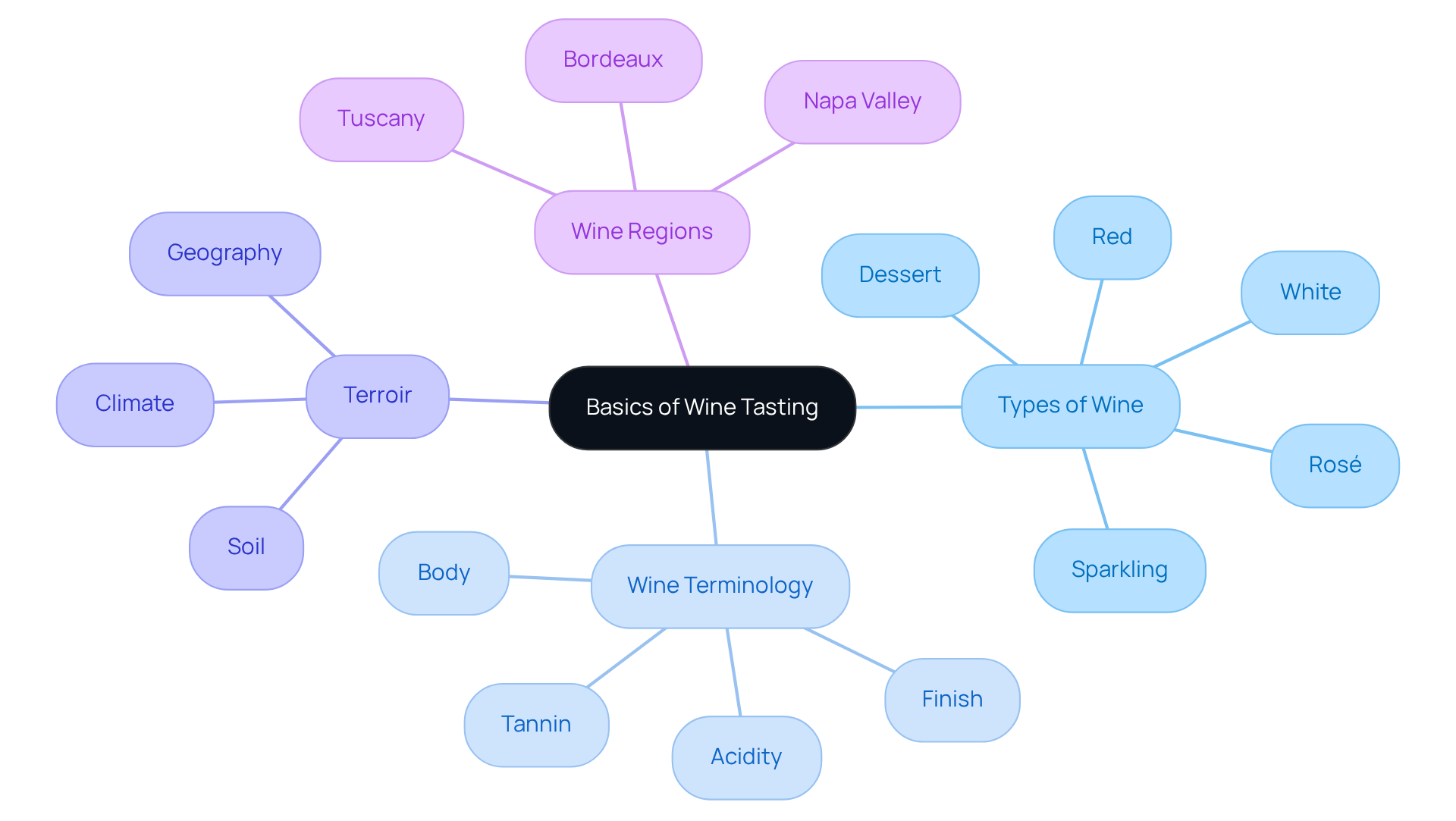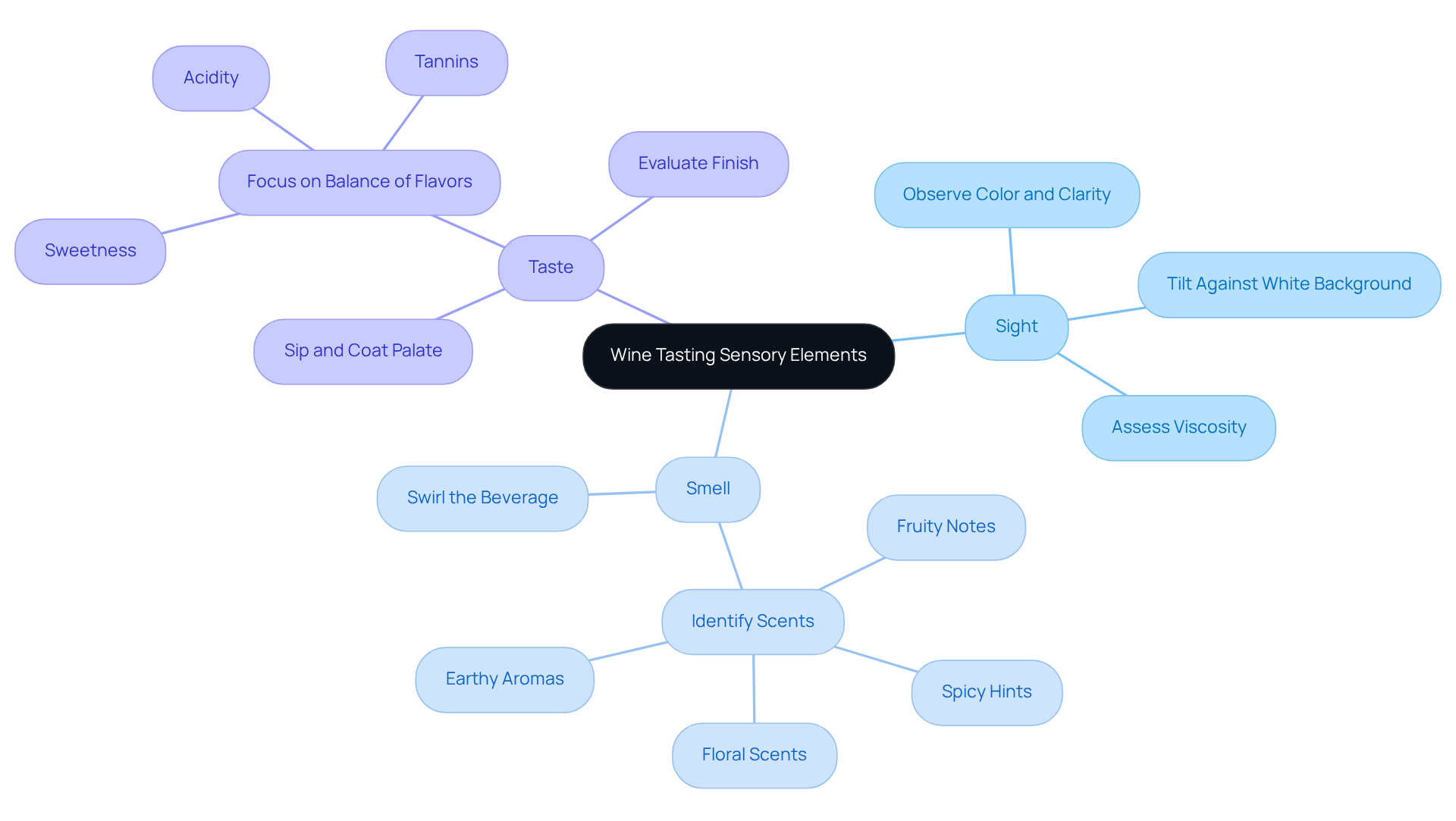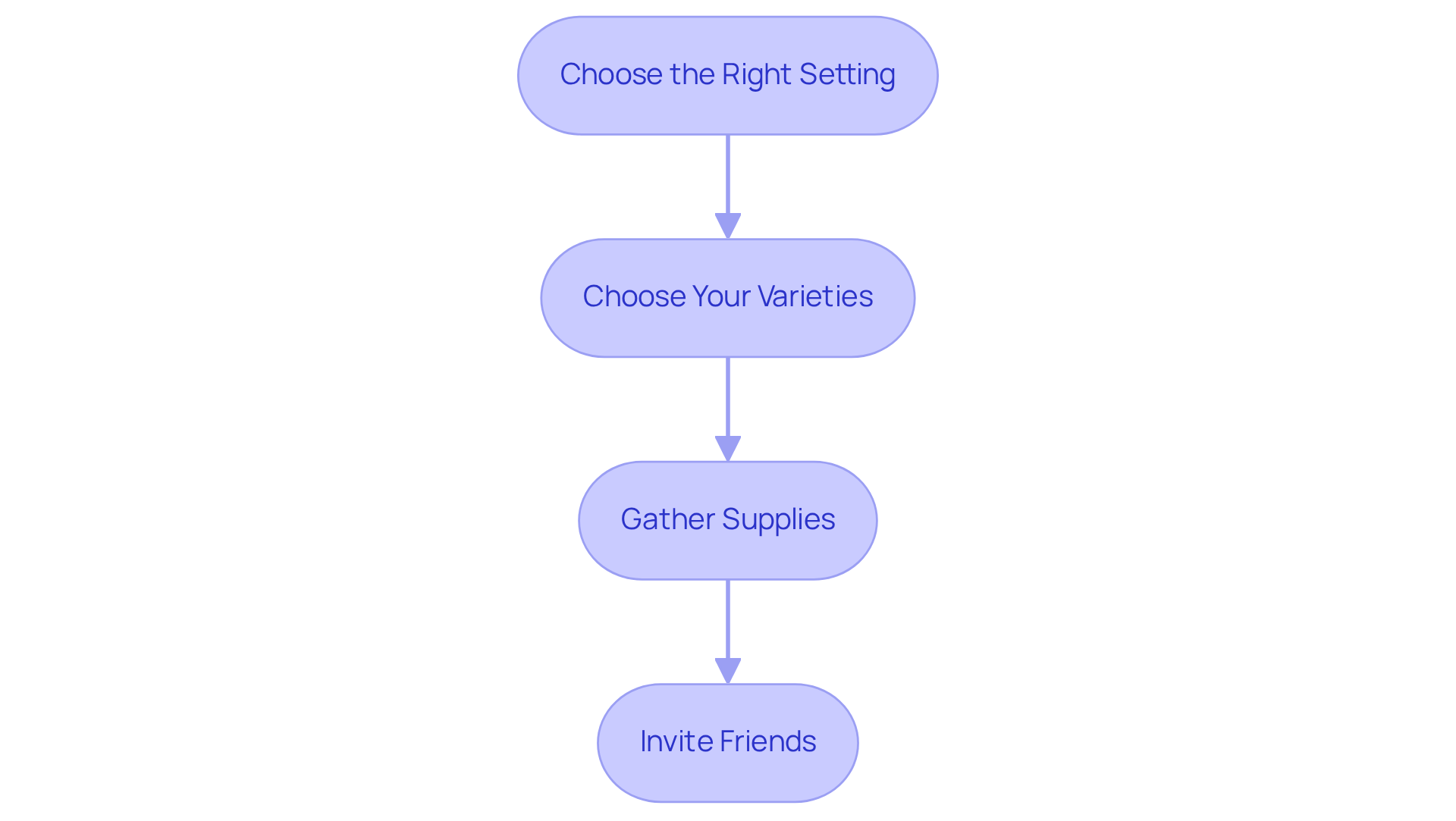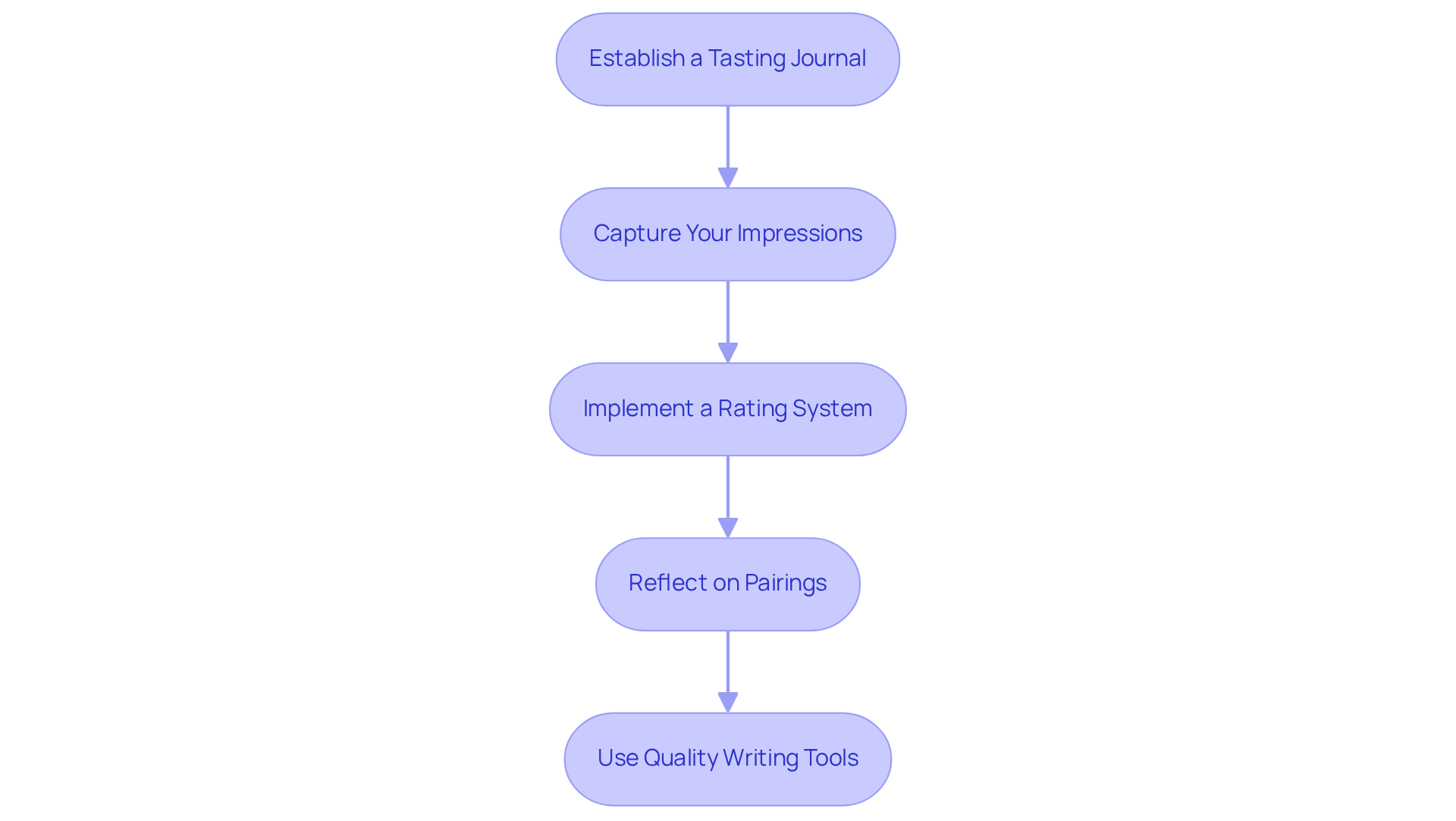Overview
To cultivate an appreciation for wine, it is essential for beginners to familiarize themselves with the various types of wine, grasp essential tasting terminology, and engage their senses of sight, smell, and taste. This article underscores the importance of these foundational elements by outlining practical steps for effective wine tasting preparation. Key actions include:
- Selecting a diverse range of wines
- Creating a comfortable tasting environment
- Meticulously documenting tasting experiences
These practices not only enhance enjoyment but also deepen one’s appreciation for the complexities of wine.
Introduction
Navigating the world of wine can appear intimidating to those new to it, brimming with intricate terminology and an overwhelming selection of options. Yet, the path to appreciating this timeless beverage is not only within reach but also immensely gratifying. This guide presents essential steps for novices to develop a genuine appreciation for wine, encompassing the fundamentals of tasting and delving into the sensory elements that elevate the experience. Could it be that the secret to igniting a newfound passion lies in simple practices and mindful exploration?
Understand the Basics of Wine Tasting
Embarking on your journey with this beverage begins with a solid understanding of how to start liking wine and the fundamentals of tasting. Grasping these key points will significantly enhance your experience:
- Types of Wine: Familiarize yourself with the primary categories: red, white, rosé, sparkling, and dessert wines. Each type boasts unique characteristics and taste profiles that are essential to recognize.
- : Equip yourself with essential terms such as 'body', 'tannin', 'acidity', and 'finish'. Mastering this vocabulary will empower you to articulate your tasting experiences with confidence.
- Terroir: Recognize that the environment in which grapes are cultivated—including soil, climate, and geography—profoundly influences the flavor of the beverage.
- Wine Regions: Acquaint yourself with renowned regions such as Bordeaux, Napa Valley, and Tuscany, as each produces distinct styles of wine that reflect their unique terroirs.
By mastering these fundamentals, you position yourself to discover how to start liking wine and to appreciate the diverse world of beverages more fully.

Explore the Sensory Elements: Sight, Smell, and Taste
Wine tasting represents a that intricately engages sight, smell, and taste. To fully immerse yourself in this process, consider the following elements:
- Sight: Begin by observing the beverage's color and clarity. Tilt the glass against a white background to appreciate its hue. A deeper color often suggests a fuller-bodied beverage, while clarity indicates quality; well-crafted products should appear clear and bright.
- Aroma: Gently swirl the beverage in the glass to release its fragrant compounds. Take a moment to inhale deeply, identifying various scents such as fruity, floral, or spicy notes. This step is crucial, as research indicates that aromatic substances play a vital role in the overall quality of the beverage, significantly influencing taste perception.
- Taste: Take a small sip, allowing the beverage to coat your palate. Concentrate on the tastes that arise, paying attention to the balance of sweetness, acidity, and tannins. The finish, or how long the flavors linger after swallowing, reveals much about the beverage's complexity.
Engaging in these sensory assessments not only deepens your appreciation for the beverage but also provides insights on how to start liking wine while enhancing your skill in articulating its subtleties. Consistent practice and attentive sampling can teach you how to start liking wine, making each tasting occasion more enjoyable and enlightening. Keeping a beverage sampling journal and participating in a community of connoisseurs can further enrich your understanding and admiration of the drink.

Prepare for Your Wine Tasting Experience
To maximize your wine tasting experience, consider these essential preparation steps:
- Choose the Right Setting: Select a quiet, comfortable space with warm lighting, ideally between 2,700K and 3,000K, to cultivate an inviting atmosphere. Ensure the area is devoid of strong scents that could obstruct your ability to appreciate the beverage's aroma. Maintain a between 68-70°F (20-21°C) for guest comfort and optimal beverage quality.
- Choose Your Varieties: Begin with a diverse assortment of beverages to explore various styles. A balanced selection of 8-10 varieties is recommended, including two to three white options and six to seven red choices, along with a sparkling alternative to refresh the palate. Popular picks for beginners in 2025 include Chardonnay from Chablis, Pinot Noir from Burgundy, and Sauvignon Blanc from Sancerre.
- Gather Supplies: Prepare clean glasses—aim for two to three per guest for accurate comparisons—and have a spittoon available if you prefer not to swallow. Water for palate cleansing and snacks such as bread or cheese will assist in neutralizing your palate between samples. Consider employing basic signage, such as tent cards or small chalkboards, to display varieties and notes.
- Invite Friends: Wine sampling is significantly more enjoyable with company. Invite friends who share a passion for discovering more about beverages, transforming the event into an enjoyable and informative occasion. Incorporating activities, such as blind sampling or voting on favorites, can enhance interaction and enjoyment.
By adhering to these steps, you will establish the foundation for an enjoyable and enlightening sampling event that promotes exploration and appreciation of various beverages.

Document Your Wine Impressions for Future Reference
Recording your beverage sampling experiences is not just a beneficial habit; it is a practice that can significantly enhance your enjoyment and understanding of how to start liking wine. Here’s how to effectively capture your impressions:
- Establish a Tasting Journal: Select a dedicated notebook or a digital app to log your tastings. Include essential details such as the beverage's name, vintage, region, and producer. Many enthusiasts prefer journals like the Leuchtturm1917, which has been a favorite for over 20 years due to its robust design and customizable features, making it ideal for this purpose.
- Capture Your Impressions: Document your thoughts on the beverage's appearance, aroma, taste, and finish. Observing the beverage's appearance can provide vital clues about its age, clarity, and flavor profile. Be descriptive and honest regarding what you enjoyed or found lacking. Engaging all your senses during this process will deepen your connection to the beverage.
- Implement a Rating System: Consider employing a simple rating scale (e.g., 1-5 stars) to help you remember your favorites. This method is favored by beverage aficionados, with research indicating that a significant portion of them record their sampling activities to monitor preferences and trends.
- Reflect on Pairings: If you enjoyed a beverage with a specific dish, document that pairing. Acknowledging these experiences can guide your future choices and enhance your overall tasting journey. Pairing beverages with food, such as cheese or chocolate, can create a delightful experience that elevates the flavors of both.
- Use Quality Writing Tools: Opt for Staedtler Triplus Fineliner Pens for note-taking, as they are designed to prevent smearing and bleeding, ensuring your notes remain clear and legible.
By consistently documenting your impressions, you will create a personalized reference that not only guides your future wine choices but also teaches you how to start liking wine and enriches your appreciation for the craft of winemaking.

Conclusion
Embarking on the journey to appreciate wine is not merely an indulgence; it is an enriching blend of knowledge, sensory exploration, and personal experience. Understanding the fundamentals of wine tasting—encompassing various types, terminology, and the profound impact of terroir—can significantly elevate one’s enjoyment of this complex beverage. By engaging the senses—sight, smell, and taste—while thoughtfully preparing for tasting events, individuals create an enriched experience that fosters a deeper connection with wine.
Key insights discussed throughout this article underscore the critical importance of preparation. Selecting the right environment, choosing diverse varieties, and documenting tasting impressions are essential steps. Establishing a tasting journal serves not only as a means to remember favorites but also enhances future wine selections and pairings. This structured approach empowers beginners to immerse themselves in the world of wine, making the process both enjoyable and educational.
Ultimately, the journey of learning to appreciate wine is a personal one that invites exploration and discovery. By actively participating in tastings, engaging with fellow enthusiasts, and documenting experiences, individuals can cultivate a genuine appreciation for wine. This adventure enriches one’s palate and opens doors to new experiences, making wine tasting a fulfilling pursuit worth embracing.
Frequently Asked Questions
What are the main types of wine?
The main types of wine are red, white, rosé, sparkling, and dessert wines. Each type has unique characteristics and taste profiles.
What wine terminology should I know?
Essential wine terminology includes terms like 'body', 'tannin', 'acidity', and 'finish'. Understanding these terms will help you articulate your tasting experiences.
How does terroir affect wine?
Terroir refers to the environment in which grapes are cultivated, including factors like soil, climate, and geography, which profoundly influence the flavor of the wine.
Which wine regions should I be familiar with?
Notable wine regions to know include Bordeaux, Napa Valley, and Tuscany, as each region produces distinct styles of wine that reflect their unique terroirs.
How can mastering these fundamentals enhance my wine experience?
By mastering the basics of wine types, terminology, terroir, and regions, you can better appreciate and enjoy the diverse world of wines.




